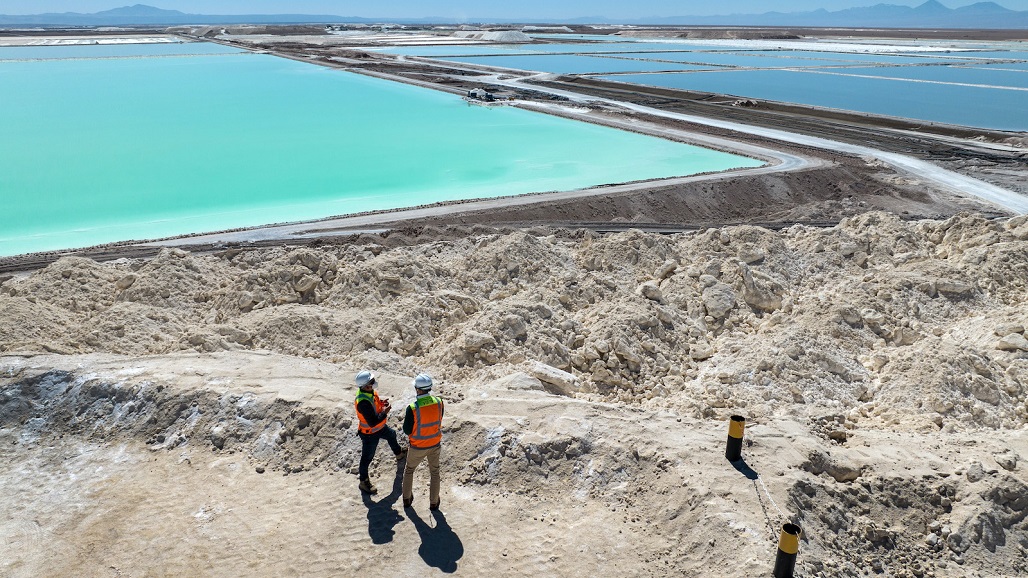In this aerial view, visitors stand atop a large mound of salt bi-product from lithium production at a mine in the Atacama Desert on August 24, 2022 in Salar de Atacama, Chile. Albemarle Corporation, based in Charlotte, N.C. is expanding mining operations there to meet the rising global demand for lithium carbonate, a main component in the manufacture of batteries, increasingly for electric vehicles.
Photo by John Moore/Getty Images
 Inflation was always set to be the hot topic at our 2022 U.S. Global Investment Forum (GIF), given the economic and geopolitical backdrop to the event. Five Mercer investment specialists examined the potential and presented their case for five inflation-hedging assets, in no particular order of importance or effectiveness.
Inflation was always set to be the hot topic at our 2022 U.S. Global Investment Forum (GIF), given the economic and geopolitical backdrop to the event. Five Mercer investment specialists examined the potential and presented their case for five inflation-hedging assets, in no particular order of importance or effectiveness.
Private Debt
Jason Sookhoo, senior investment consultant, Mercer, believes two key headwinds facing conventional fixed income portfolios are laying the foundation for a pivot towards private debt — inflation-eroding bond returns and rising rates having a negative return impact due to duration and credit spreads.
Sookhoo said that private debt can help mitigate these risks as the floating rate component attached to private debt investments rises as market rates rise, hedging an inflationary risk by mitigating duration.
Secondly, private debt markets are not valued every day, so valuations come with a time lag. Unless a sell-off lasts for a prolonged period of time, it is not as sensitive to credit spreads as publicly traded debt is and has led to smoother return profiles.
Gold
Following Sookhoo on stage was Travis Simon, alternatives investment specialist at Mercer. He explained the role gold can play in a portfolio, describing how the metal has stood the test of time and is revered by investors and collectors alike.
“Gold is often called the ultimate fear asset,” Simon told GIF attendees. Unlike other commodities and real assets, gold is seen as a store of value and a currency. This has provided significant downside protection relative to other assets. The value of gold has risen nine times in the last 15 equity market sell-offs, said Simon. Looking at current markets, gold is relatively flat, while equities and some bonds are down double digits. Additionally, in low-rate and low-opportunity environments, such as the decade before 2020, gold performs even better.
This potential downside protection, coupled with a store of value, further bolsters the case for gold as a diversifying asset to traditional fixed income and equity portfolios.
Listed infrastructure has historically outperformed global equities and fixed income in periods of rising inflation, and even more in times of unexpected inflation.
Natural Resources
Next, Nick Barron, senior investment consultant, took the stage to outline how in the natural resources space, factors on both the demand and supply sides are creating an environment for investors to hedge inflationary risks.
On the demand side, emerging market economies are becoming more developed, and developed economies are becoming more sophisticated, fueling continued demand for these materials. Yet the supply side is limited given the finite availability of these resources, and technological advances will not offset that demand.
“We think that may lead to higher prices, which will ultimately benefit the natural resource producers over the long run,” said Barron, while higher prices on natural resources will have a huge impact on inflation itself. Exposure to this sector can help mitigate the long-term structural impact of inflation on an investor’s portfolio. Additionally, natural resource strategies can be tailored to meet growing ESG requirements.
Commodities
Next to take the stage was Ashley Holder, investment consultant. She described the strong historical relationship between commodities and inflation and noted that commodities tend to exhibit a high “inflation beta.” Because of this, commodities can make a meaningful contribution at the total portfolio level with even a low portfolio allocation, making them a great candidate for inclusion in an inflation-sensitive portfolio.
Commodities tend to perform well in supply driven, stagflationary shock scenarios of rising inflation and falling growth. Structural trends, such as the pace of globalization possibly slowing down, more volatile geopolitics and a renewed focus on self-reliance by countries and companies, could lead permanently to more constrained supply chains and tighter commodity supply going forward, which increases the likelihood of these supply-driven, stagflationary shock scenarios. Compounding this, further infrastructure spending will also increase demand for commodities going forward.
Holder also described the various routes to accessing commodities, be it futures contracts, hedge funds or natural resource equities. “Futures contracts offer the most direct exposure to commodity prices and are one of the most direct exposures to inflation hedging characteristics,” she said.
Institutional investors have overlooked commodities over recent years, but Mercer believes now may be the perfect time for investors to take another look at their portfolio and consider adding commodities going forward.
Listed Infrastructure
And I just had to keep for myself what I believe to be the best topic — infrastructure. Infrastructure is made up of assets that are essential to society and act as the backbone of the economy, so infrastructure companies benefit from stable demand. Many infrastructure companies are regulated with little to no competition, which gives owners and operators leverage to hedge inflation. The pricing models of infrastructure companies often have built-in increases for inflation, such as long-term contracts with annual CPI-based increases.
While a cost increase can be irritating when you’re paying your toll or utility bill, investors can use infrastructure as an inflation hedge owing to pricing mechanisms already in place, but also because of its more defensive, less cyclical nature. Listed infrastructure has historically outperformed global equities and fixed income in periods of rising inflation, and even more in times of unexpected inflation.
So, as we look ahead to the coming months, remember that deciding on an inflation-hedging strategy is not simply about hiding assets away. Rather, it is about leveraging the vast array of available options in tandem with your existing portfolio to keep you on track to reach your long-term financial goals.
Related themes: INFLATION INVESTMENT
 Liisa MacNicholas
Liisa MacNicholas
Investment consultant at Mercer
Liisa MacNicholas is an investment consultant at Mercer.
The original report can be read at the Brink’s website HERE.


Leave a Reply